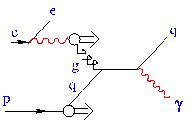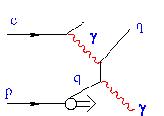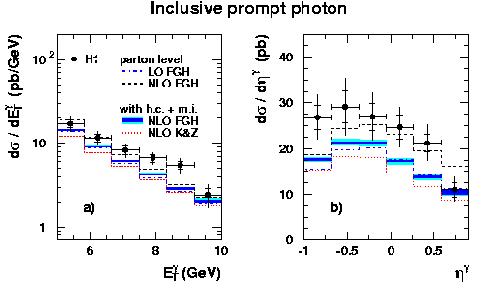
 At the HERA electron proton collider, there are a number of complementary
ways of probing the partonic structure of the proton and photon and of
understanding the dynamics of the strong
interactions
which take place between them. In this paper, we study the
emission of ``prompt'' photons directly from the hard sub-process at
the heart of the interaction. Example processes are shown in the figures
for direct (left) and resolved (right) photon interactions.
Although prompt photon cross sections are rather small,
the process has a number of advantages over other observables.
In particular, the experimentally observed photons
can be related directly to the event structure at the parton level, in
contrast to the case of
hadronic jet production, where the hadronisation process obscures
the parton level structure. In this paper, prompt photons are studied both
inclusively, and in association with jets of hadrons. The finely segmented
H1 Liquid Argon Calorimeter ensures good measurements of both the photons
and the jets.
At the HERA electron proton collider, there are a number of complementary
ways of probing the partonic structure of the proton and photon and of
understanding the dynamics of the strong
interactions
which take place between them. In this paper, we study the
emission of ``prompt'' photons directly from the hard sub-process at
the heart of the interaction. Example processes are shown in the figures
for direct (left) and resolved (right) photon interactions.
Although prompt photon cross sections are rather small,
the process has a number of advantages over other observables.
In particular, the experimentally observed photons
can be related directly to the event structure at the parton level, in
contrast to the case of
hadronic jet production, where the hadronisation process obscures
the parton level structure. In this paper, prompt photons are studied both
inclusively, and in association with jets of hadrons. The finely segmented
H1 Liquid Argon Calorimeter ensures good measurements of both the photons
and the jets.
The main experimental difficulty in studying prompt photons is the presence of backgrounds from the decays of hadrons such as pi0 mesons, which decay to pairs of photons. At high energies of the pion, the decay photons cannot be resolved in the detector and can be mistaken for a single photon. These backgrounds are distinguished from the prompt photon signal contribution in this paper on a statistical basis, using a shower shape analysis. This exploits the fact that a single prompt photon will typically yield a narrower shower in the calorimeter than a pair of photons, with a larger fraction of the energy contained in the centre of the shower and with a smaller fraction deposited near the surface of the calorimeter. The observed distributions in variables characterising the shower shape are thus subjected to fits in order to extract the contributions from prompt photons and from backgrounds.
 Examples of the results are shown in the figures on the left. Here the
inclusive
cross section for prompt photon production is shown differentially in the
transverse energy and the pseudorapidity of the photon. The data are
compared with the predictions of next-to-leading order QCD according to
two different calculations. Comparing the data for example with the band
representing the FGH prediction shows that the
best theoretical calculations
lie below the data by some 30-40%. This observation is similar to that from
previously reported studies by other experiments.
Examples of the results are shown in the figures on the left. Here the
inclusive
cross section for prompt photon production is shown differentially in the
transverse energy and the pseudorapidity of the photon. The data are
compared with the predictions of next-to-leading order QCD according to
two different calculations. Comparing the data for example with the band
representing the FGH prediction shows that the
best theoretical calculations
lie below the data by some 30-40%. This observation is similar to that from
previously reported studies by other experiments.
Interesting insight into these discrepancies is gained when studying the
prompt photon cross sections with the additional requirement of a high
transverse momentum hadronic jet, corresponding more closely to the
final states shown in the Feynman diagrams above. Although
the data still lie above the predictions, the description is somewhat
improved (see figure 4 of the paper).
This, together with the fact that the NLO / LO corrections in
the theoretical predictions are significantly smaller in the case with
associated jets, seems to suggest that the uncalculated higher order QCD
corrections beyond NLO may explain the discrepancies observed
in the inclusive prompt photon case.